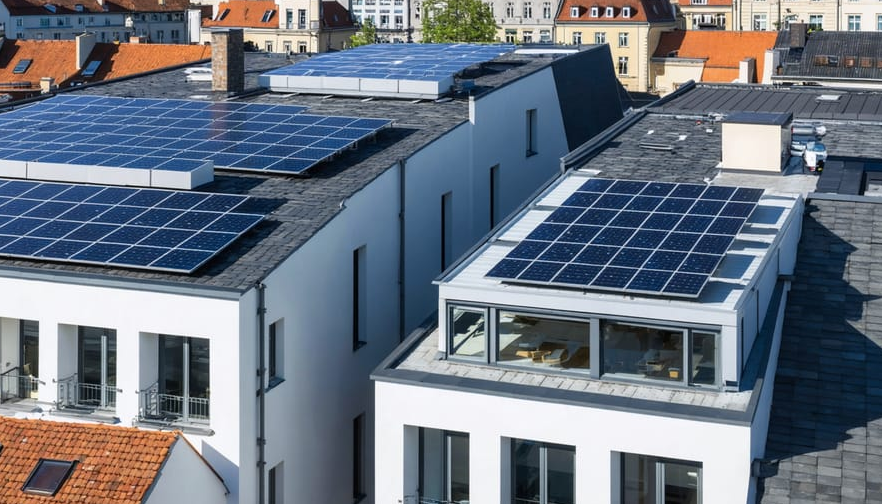
Building Integrated Photovoltaic Panels Revolutionizing Sustainable Architecture
Building integrated photovoltaic panels (BIPV) are solar energy systems designed to replace traditional building materials, becoming an integral part of a structure’s surfaces like roofs, façades, or windows. They generate electricity while serving as functional components of the building envelope, blending energy production with architecture.
This dual-purpose approach means BIPV not only contributes to reducing energy costs but also supports sustainable building design without disrupting the aesthetic or structural elements. By seamlessly integrating solar technology, BIPV offers a practical solution for new constructions or retrofits aiming for energy efficiency.
As interest in renewable energy grows, BIPV stands out for combining clean power generation with building materials, creating opportunities for greener buildings without compromising form or function.
Building Integrated Photovoltaic Panel Technology
Building integrated photovoltaic (BIPV) panels combine solar power generation with building materials. They replace or integrate into façade elements like roofs, windows, and walls, serving both structural and energy-producing roles. The technology varies in design and functionality depending on application and architectural needs.
How Building Integrated Photovoltaics Work
BIPV panels convert sunlight into electricity while functioning as part of the building envelope. They use photovoltaic cells embedded within or replacing conventional materials such as glass, metal, or roofing tiles. When sunlight hits these cells, it excites electrons, producing direct current electricity.
This electricity is then converted to alternating current for building use or grid input via inverters. The seamless integration allows buildings to generate power on-site, reducing reliance on external energy sources and enhancing sustainability without compromising aesthetics.
Types of BIPV Panels
BIPV panels include several types:
- Opaque panels: Used for roofs and façades, replacing traditional cladding.
- Semi-transparent panels: Suitable for windows and skylights, balancing light transmission with energy generation.
- Bifacial panels: Capture sunlight on both sides, increasing efficiency when mounted on reflective surfaces.
Materials commonly involve crystalline silicon cells, thin-film technologies, and emerging options like perovskites. Selection depends on building requirements, location, and desired energy output.
Design and Architectural Integration
BIPV panels are designed to match or enhance building aesthetics, offering customization in shape, color, and texture. Integration involves collaboration between architects and engineers to ensure structural integrity and energy performance.
They serve multiple roles: weather protection, insulation, and solar shading, while producing electricity. Digital design tools help optimize placement for sunlight exposure, improving energy yield without altering architectural intent. BIPV thus merges sustainability with functional design.
See also: Technology-Enhanced Assessment Methods
Benefits and Key Applications
Building-integrated photovoltaic (BIPV) panels offer practical advantages in both energy production and building design. They directly contribute to reducing energy consumption while serving multiple functional and aesthetic purposes. Their use spans various sectors, providing measurable benefits in cost savings and environmental impact.
Energy Efficiency and Sustainability
BIPV systems generate electricity on-site by embedding photovoltaic cells into building materials like roofs, facades, and windows. This on-site generation reduces reliance on external power sources, improving overall energy efficiency.
They enable buildings to approach or meet their energy demands through renewable production. Many advanced technologies within BIPV, such as bifacial and semi-transparent cells, increase the efficiency and flexibility of solar energy capture.
By integrating energy generation into the building envelope, BIPV contributes to lower greenhouse gas emissions. This integration supports sustainability goals by reducing fossil fuel consumption and the building’s carbon footprint.
Economic and Environmental Advantages
One notable economic benefit of BIPV is the significant reduction in electricity bills. Generating power on-site protects users from fluctuating energy prices, providing a degree of financial stability.
BIPV also increases building value by combining renewable energy with architectural design. This appeal can attract environmentally conscious tenants or buyers, enhancing marketability.
Environmentally, BIPV reduces dependency on traditional energy grids, lowering demand on fossil fuels. It also supports green building certifications, which can yield incentives and elevate a building’s sustainability profile.
The key challenge remains the higher initial investment compared to conventional materials. However, long-term energy savings and reduced operational costs often offset these upfront expenses.
Commercial and Residential Use Cases
In commercial settings, BIPV panels integrate into office buildings, shopping centers, and industrial facilities. They provide energy cost reductions and enhance building aesthetics, aligning with corporate sustainability initiatives.
Residential applications include installation on rooftops, skylights, and facades. Homeowners benefit from lowered electricity expenses and increased property value. The design flexibility of BIPV allows for seamless integration without compromising architectural style.
Both sectors leverage BIPV to portray innovation and environmental responsibility. This reputation is increasingly important as sustainability becomes a priority among investors, occupants, and regulatory bodies.



